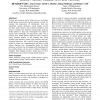Free Online Productivity Tools
i2Speak
i2Symbol
i2OCR
iTex2Img
iWeb2Print
iWeb2Shot
i2Type
iPdf2Split
iPdf2Merge
i2Bopomofo
i2Arabic
i2Style
i2Image
i2PDF
iLatex2Rtf
Sci2ools
CHI
2011
ACM
2011
ACM
Improving the safety of homeless young people with mobile phones: values, form and function
By their pervasiveness and by being worn on our bodies, mobile phones seem to have become intrinsic to safety. To examine this proposition, 43 participants, from four stakeholder groups (homeless young people, service providers, police officers, and community members), were asked to consider how homeless young people could use mobile phones to keep safe. Participants were asked to express their knowledge for place-based safety and to envision how mobile phones might be used to improve safety. Detailed analysis of the resulting data, which included value sketches, written value scenarios, and semistructured discussion, led to specific design opportunities, related to values (e.g., supporting trust and desire to help others), function (e.g., documenting harms for future purposes), and form (e.g., leveraging social expectations for how mobile phones can be used to influence behavior). Together, these findings bound a design space for how mobile phones can be used to manage unsafe situati...
CHI 2011 | Design Opportunities | Human Computer Interaction | Security Value | Stakeholder Groups |
| Added | 25 Aug 2011 |
| Updated | 25 Aug 2011 |
| Type | Journal |
| Year | 2011 |
| Where | CHI |
| Authors | Jill Palzkill Woelfer, Amy Iverson, David G. Hendry, Batya Friedman, Brian T. Gill |
Comments (0)

